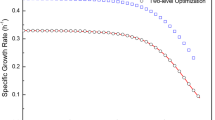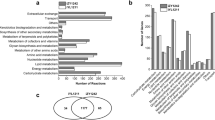Abstract
A variety of microorganism species are able naturally to produce 2,3-butanediol (2,3-BDO), although only a few of them are suitable for consideration as having potential for mass production purposes. Klebsiella pneumoniae (K. pneumoniae) is one such strain which has been widely studied and used industrially to produce 2,3-BDO. In the central carbon metabolism of K. pneumoniae, the 2,3-BDO synthesis pathway is dominated by three essential enzymes, namely acetolactate decarboxylase, acetolactate synthase, and butanediol dehydrogenase, which are encoded by the budA, budB, and budC genes, respectively. The mechanisms of the three enzymes have been characterized with regard to their function and roles in 2,3-BDO synthesis and cell growth (Blomqvist et al. in J Bacteriol 175(5):1392–1404, 1993), while a few studies have focused on the cooperative mechanisms of the three enzymes and their mutual interactions. Therefore, the K. pneumoniae KCTC2242::ΔwabG wild-type strain was utilized to reconstruct seven new mutants by single, double, and triple overexpression of the three enzymes key to this study. Subsequently, continuous cultures were performed to obtain steady-state metabolism in the organisms and experimental data were analyzed by metabolic flux analysis (MFA) to determine the regulation mechanisms. The MFA results showed that the seven overexpressed mutants all exhibited enhanced 2,3-BDO production, and the strain overexpressing the budBA gene produced the highest yield. While the enzyme encoded by the budA gene produced branched-chain amino acids which were favorable for cell growth, the budB gene enzyme rapidly enhanced the conversion of acetolactate to acetoin in an oxygen-dependent manner, and the budC gene enzyme catalyzed the reversible conversion of acetoin to 2,3-BDO and regulated the intracellular NAD+/NADH balance.




Similar content being viewed by others
References
Blomqvist K, Nikkola M, Lehtovaara P, Suihko ML, Airaksinen U, Stråby KB, Knowles JK, Penttilä ME (1993) Characterization of the genes of the 2,3-butanediol operons from Klebsiella teerigena and Enterobacter aerogenes. J Bacteriol 175(5):1392–1404
Goupil-Feuillerat N, Cocaigen-Bousquet M, Codon J-J, Ehrlich SD, Renault P (1997) Dual role of α-acetolactate decarboxylase in Lactococcus lactis subsp. Lactis. J Bacteriol 179(20):6285–9293
Platteeuw C, Hugenholtz J, Starrenburg M, van Alen-Boerrigter I, de Vos WM (1995) Metabolic engineering of Lactococcus lactis: influence of the overproduction of alpha-acetolactate synthase in strains deficient in lactate dehydrogenase as a function of culture conditions. Appl Environ Microbiol 61(11):3967–3971
Bryn K, Hetland Ø, Størmer FC (1971) The reduction of diacetyl and acetoin in Aerobacter aerogenes evidence for on enzyme catalyzing both reactions. Eur J Biochem 18(1):116–119
Izquierdo L, Coderch N, Piqué N, Benini E, Corsaro MM, Merino S, Fresno S, Tomás JM, Regué M (2003) The Klebsiella pneumoniae wabG gene: role in biosynthesis of the core lipopolysaccharide and virulence. J Bacteriol 185(24):7213–7221
Kim BR, Lee SJ, Park JH, Lu MS, Oh MK, Kim YR, Lee JW (2012) Enhanced 2,3-butanediol production in recombinant Klebsiella pneumoniae via overexpression of synthesis-related genes. J Mircrobiol Biotechnol 22(9):1258–1263
Stephanopoulos GN, Aristido AA, Nielsen J (1998) Metabolic engineering principles and methodologies. Academic Press, San Diego
Sauer U, Hatzimanikatis V, Hohmann HP, Manneberg M, van Loon AP, Bailey JE (1996) Physiology and metabolic fluxes of wild-type and riboflavin-producing Bacillus subtilis. Appl Environ Microbiol 62(10):3687–3696
Neidhardt FC, Ingraham JL, Schaechter M (1990) Physiology of the bacterial cell: a molecular approach. Sinauer Associate, Inc. Sunderland
Ji XJ, Huang H, Ouyang PK (2011) Microbial 2,3-butanediol production: a state-of-the-art review. Biotechnol Adv 29(3):351–364
Hoefnagel MHN, Starrenburg MJC, Martens DE, Hugenholtz J, Kleerebezem M, van Swam II, Bongers R, Westerhoff HV, Snoep JL (2002) Metabolic engineering of lactic acid bacteria, the combined approach: kinetic modeling, metabolic control and experimental analysis. Microbiology 148:1003–1013
Nissen TL, Schulze U, Nielsen J, Villadsen J (1997) Flux distributions in anaerobic, glucose-limited continuous cultures of Saccharomyces cerevisiae. Microbiology 143:203–218
Lorenz MC, Fink GR (2002) Life and death in a macrophage: role of the glyoxylate cycle in virulence. Eukaryot Cell 1(5):657–662
Monnet C, Nardi M, Hols P, Gulea M, Corrieu G, Monnet V (2003) Regulation of branched-chain amino acid biosynthesis by α-acetolactate decarboxylase in Streptococcus thermophilus. Lett Appl Microbiol 36:399–405
Celińska E, Grajek W (2009) Biotechnological production of 2,3-butanediol: current state and prospects. Biotechnol Adv 20:715–725
Acknowledgments
This work was supported by the Industrial Strategic technology development program (10035147, Development of 2,3-butanediol and derivative production technology for C-Zero bio-platform industry) funded by the Ministry of Knowledge Economy (MKE), Republic of Korea.
Author information
Authors and Affiliations
Corresponding author
Appendix: List of metabolic reactions
Appendix: List of metabolic reactions
-
1.
Phosphotransferase system (PTS): glucose + pep → g6p + pyr
-
2.
Phosphoglucose isomerase (PGI): g6p → f6p
-
3.
Polysaccharide synthesis (PSS): g6p → Polysaccharide
-
4.
Phosphafructokinase (PFK): f6p + [ATP] → fdp + [ADP]
-
5.
Aldolases (ALDO): fdp → dhap + gap
-
6.
Triosphosphate isomerase (TIS): dhap = gap
-
7.
Glyceraldehyde-3-phosphate dehydrogenase (GAPHD): gap + [NAD] = pgp + [NADH] + [h]
-
8.
Phosphoglycerate kinase (PGK): pgp + [ADP] + [Pi] = 3 pg + [ATP]
-
9.
Phosphoglycerate mutase (PGLUMU): 3 pg = 2 pg
-
10.
Enolase (ENO): 2 pg → pep
-
11.
Pyruvate kinase (PK): pep + [ADP] + [h] = pyr + [ATP]
-
12.
Glucose-6-phosphate dehydrogenase (G6PDH): g6p + [NADP] → 6 pg + [NADPH] + 2[h]
-
13.
6-Phosphogluconate dehydrogenase (PGDH): 6 pg + [NADP] → ribu5p + [CO2] + [NADPH]
-
14.
Ribulose phosphate 3-epimerase (RU5P): ribu5p = xyl5p
-
15.
Ribose-5-phosphate isomerase (R5PI): ribu5p = rib5p
-
16.
BIOMASS(ex): 0.101rib5p + 0.043e4p + 0.037g6p + 0.0556g6p + 0.0407pep + 0.333pyr + 0.17oxa + 0.12accoA + 1.73[ATP] + 2.120[NAD] + 1.89[NADPH] → Biomass + 1.73[ADP] + 2.12[NADH] + 1.89[NADP]
-
17.
Transketolase A (TKA): rib5p + xyl5p = gap + sed7p
-
18.
Transaldolase (TA): gap + sed7p = e4p + f6p
-
19.
Transketolase B (TKB): e4p + xyl5p = f6p +gap
-
20.
Pyruvate dehydrogenase (PDH): pyr + [NAD] + coA → accoA + [NADH] + [CO2]
-
21.
Citrate synthase (CS): accoA + oxa + [H2O] → cit + coA
-
22.
Aconitase (CAN): cit = icit
-
23.
Isocitrate dehydrogenase (ICD): icit + [NAD] + [CO2] = akg + [NADH]
-
24.
2-Ketoglutarate dehydrogenase (KDH): akg + [NAD] → succoA + [NADH] + [CO2]
-
25.
Succinate thiokinase (SCAS): succoA + [ADP] + Pi = succinate + [ATP] + coA
-
26.
Succ(ex): succinate → succinate(ex)
-
27.
Succinate dehydrogenase (SDH): succinate + [fad] → fum + [fadh2]
-
28.
Fumarase (FUM): fum + [H2O] = mal
-
29.
Malate dehydrogenase (MDH): mal + [NAD] = oxa + [NADH] + [h]
-
30.
PEP carboxykinase (PCK): oxa + [ATP] = pep + [ADP] + [CO2]
-
31.
Lactate dehydrogenase (LDH): pyr + [NADH] → Lactate + [NAD]
-
32.
Lactate → Lactate(ex)
-
33.
Acetolactate synthase (ALS): 2 pyr → aclac
-
34.
Acetolactate decarboxylase (ALDC): aclac → acet
-
35.
Acetoin dehydrogenase (ACETDH): acet + [NADH] → 2,3-BDO + [NAD]
-
36.
2,3-BDO → 2,3-BDOex
-
37.
Aldehyde dehydrogenase (ACALDH): accoA + [NADH] → acal + [NAD] + coA
-
38.
Alcohol dehydrogenase (ADH): acal + [NADH] + [h] → Ethanol + [NAD]
-
39.
Ethanol → Ethanol(ex)
-
40.
NADH dehydrogenase I: [NADH] + [Q] = [NAD] + [QH2] + 2 [h]
-
41.
Cytochrome oxidase bo3: 2 [QH2] + [O2] = 2 [Q] + 4 [h]
-
42.
Pyridine nucleotide transhydrogenase: [NADPH] + [NAD] = [NADP] + [NADH]
-
43.
Succinate dehydrogenase complex: [fadh2] + [Q] = [QH2] + [fad]
-
44.
Pyridine nucleotide transhydrogenase: [NADP] + [NADH] + 2 [h] = [NADPH] + [NAD]
-
45.
ATP drain: [ATP] = [ADP] + [Pi]
-
46.
CO2 → CO2(ex)
-
47.
O2 = O2(ex)
-
48.
Pi = Pi(ex)
Rights and permissions
About this article
Cite this article
Lu, M., Park, C., Lee, S. et al. The regulation of 2,3-butanediol synthesis in Klebsiella pneumoniae as revealed by gene over-expressions and metabolic flux analysis. Bioprocess Biosyst Eng 37, 343–353 (2014). https://doi.org/10.1007/s00449-013-0999-y
Received:
Accepted:
Published:
Issue Date:
DOI: https://doi.org/10.1007/s00449-013-0999-y




